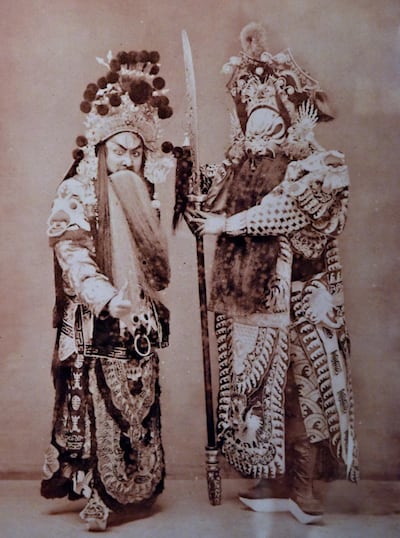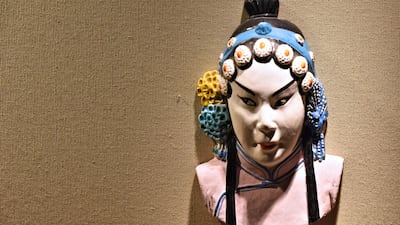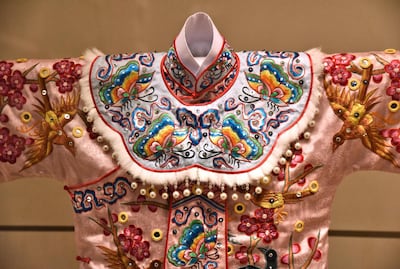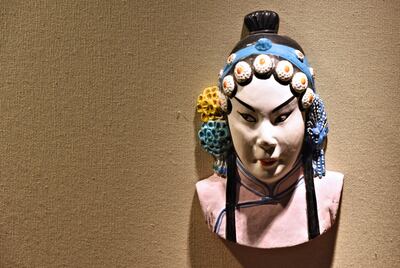I walk into the room and find them all waiting for me – the gentlemen, the women, the rough men and the clowns. These four character types form the basis of hundreds of operas that reveal stories about Chinese society, culture, religion and history.
For more than 200 years, the Peking Opera has been renowned for its elaborate costumes, intricate make-up, and the way it blends theatre, dance, singing and mime. Beijing is the hub of this art form and it is here, in the city’s Capital Museum, that I first come eye to eye with the opera’s famed characters. Inside this enormous cultural facility is a wonderfully comprehensive exhibit on the Peking Opera.
Generically called Sheng, Dan, Jing and Chou, these four character types are each defined and contrast strongly with one another – to make them easy to differentiate for the audience. The minimalist stage settings and limited special effects of the Peking Opera mean the characters must carry the show. To test how well their appearances symbolise their personality, I do not read the signs under the dolls of each character at the museum. Instead, I study their faces and costumes, and guess which is which.
As the only female character, Dan is an obvious pick. This is the name given to the female role which, depending on the opera, can vary from a matriarch figure to a female warrior or a bubbly young lady. Dan’s silk robe and brightly coloured headdress is intended to give her a regal appearance, while her white make-up is deliberately sparse to emphasis her natural beauty.
Next, I accurately guess that the doll with the quirky moustache is Chou, the clown of the Peking Opera. In contrast to Jing and Sheng, whose faces are painted with great detail, Chou’s make-up is limited and gives him a puzzled expression. This represents how the Chou character is typically portrayed – a buffoonish man who offers comic relief.
After that, I find myself stumped. I cannot pick out the final two characters from the dolls on display here, so I resort to reading the plaques beneath them. Dressed in a robe and sporting a long, dark beard, the most common version of Sheng is a genteel and honourable older man, typically a scholar or member of the Chinese nobility. He often acts as the voice of reason. The younger version of this character, known as Xiaosheng, is more lively and unpredictable, and sometimes becomes romantically involved with the Dan character.
The final character is the most forceful, the protagonist who sets Peking Opera alight. Jing is a belligerent man, often portrayed as a general, warrior or villain. His fierce personality is symbolised by his deep, booming voice and aggressive make-up.
Displays at the Capital Museum explain that, while Peking Opera is not much more than 200 years old, it was built on artistic foundations that date back to the eighth century. This is when Chinese opera was born, as Tang Dynasty Emperor Xuanzong created the country's first performing arts academy, called the Pear Garden, in the Tang capital of Chang'an. About 300 gifted actors, dancers and musicians trained each year at this academy. The aim was to form a troupe that could execute a new type of performance that blended theatre, song and dance. What they created was the Chinese opera.

This art form evolved in the following centuries, with a huge number of new styles emerging. To this day, there are more than 300 regional varieties of Chinese opera performed across the country. Henan Province’s Yu Opera has more than 100 active troupes in China, while the Cantonese Opera remains hugely popular in China’s deep south. Each of these operas has evolved to stay relevant.
In the early days of the Peking Opera, its shows were very long and deeply layered, often consisting of more than a dozen acts. More recently, to cater for the shorter attention spans of modern audiences, Peking Opera troupes perform condensed versions of classic shows including Farewell My Concubine. These operas, which tourists can watch at Beijing's Liyuan and Zhengyici Theatres, tap into China's imperial history, spirituality and belief systems.
Inspired by real events in China more than 2,000 years ago, Farewell My Concubine pits King Xiang Yu against the rebel warrior who created the Han Dynasty, Liu Bang. These men are fighting for control of a vast swathe of China. As the King becomes surrounded by Liu Bang's forces, and prepares for his imminent death, his concubine tries to lift his spirits by doing a sword dance. Then, in an act of loyalty, rather than watch her master be killed, the concubine commits suicide with his sword. This opera has been widely interpreted as a metaphor for devotion to one's country, and the honour in fighting for a just cause.
The themes of these plays, then, remain old-fashioned products of bygone eras. Yet they are universal enough, and the performances sufficiently lively, that Peking Opera continues to be one of the leading forms of live entertainment in the Chinese capital. After more than two centuries, Chinese people are still captivated by the gentlemen, the women, the rough men and the clowns.



